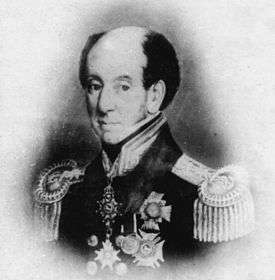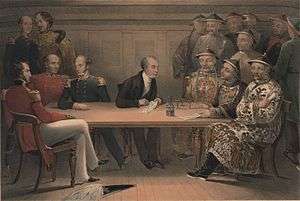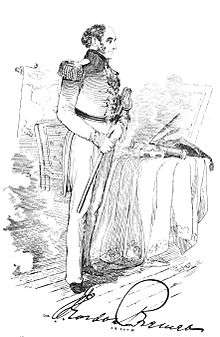Gordon Bremer
Sir James John Gordon Bremer KCB KCH (26 September 1786 – 14 February 1850) was a Royal Navy officer. He served in the Napoleonic Wars, First Anglo-Burmese War, and First Anglo-Chinese War. In China, he served twice as commander-in-chief of British forces.
Sir Gordon Bremer | |
|---|---|
 | |
| Born | 26 September 1786 Portsea, Hampshire, England |
| Died | 14 February 1850 (aged 63) Tunbridge Wells, Kent, England |
| Allegiance | |
| Service/ | |
| Years of service | 1802–1850 |
| Rank | Rear-Admiral of the Blue |
| Commands held | East Indies and China Station |
| Wars | Napoleonic Wars First Anglo-Burmese War First Anglo-Chinese War |
| Awards | CB (1815) KCH (1836) KCB (1841) China War Medal (1842) |
| Signature |  |
Born in Portsea, Portsmouth, Bremer joined the Royal Naval College as a student in 1797. While serving in the East Indies, he became commander of HMS Rattlesnake in 1807. He was promoted to captain in 1814 and was nominated a CB the following year. After becoming commander of HMS Tamar, he was sent to Melville Island, Australia, in 1824 to establish a colony. Under his leadership, the north coast of Australia from 129° to 135° longitude was claimed as British territory.
Bremer served twice as commander-in-chief of British forces in the First Anglo-Chinese War from 1839 to 1841. During the war, he took formal possession of Hong Kong Island for the United Kingdom in 1841. He was made a KCB the same year. In 1846, he was appointed with Sir Francis Augustus Collier to the joint command of the Channel Squadron and became commodore-superintendent of Woolwich Dockyard from which he retired in 1848. He died in 1850, having risen to the rank of rear-admiral.
Early career
Bremer was born on 26 September 1786 in Portsea, Hampshire, England.[1] He was the only son of Royal Navy Lieutenant James Bremer (who went missing in the East Indiaman Halswell off the coast of Dorset, England, on 6 January 1786) and his wife Ann, daughter of Captain James Norman. In 1794, as a young lad aged around 12 years old, he joined the Royal Navy as a first-class volunteer on board the flagship of HMS Sandwich at the Nore of Rear-Admiral Skeffington Lutwidge, from which he was discharged in June 1795. On 8 October 1797, he became a student of the Royal Naval College in Portsmouth, and re-embarked on 2 April 1802 as a midshipman on board HMS Endymion of Captain Philip Durham. Until July 1805, Bremer served in the flagship of HMS Isis under Vice-Admiral James Gambier and Rear-Admiral Edward Thornbrough, on the Newfoundland and North Sea stations. Shortly after passing his examination, he was appointed sub-lieutenant of the gun-brig HMS Rapid. On 3 August 1805, he became a lieutenant on board HMS Captain as part of William Cornwallis' force in pursuing a French fleet in Brest, France.[2]
On 9 May 1806, Bremer was appointed to HMS Diana of Captain Thomas James Maling in the Mediterranean Station, from where he proceeded to the Davis Strait. On 6 October, he served on board HMS Imogen of Captain Thomas Garth in the Mediterranean. On 28 May 1807, he was appointed to the Psyché of Captain William Wooldridge in the East Indies, where he became commander of HMS Rattlesnake on 13 October.[2] He became a captain on 7 June 1814.[1] On 4 June 1815, he was nominated a Companion of the Most Honourable Military Order of the Bath (CB).[2]
Australia
On 18 September 1823, just before his 37th birthday, Bremer was appointed commander of HMS Tamar. In February 1824, he was sent to Melville Island, Australia, to establish a colony.[2][1] The site was intended as a military settlement to secure British trade in the region. It was hoped that a market would open to British merchants in the Malay Archipelago.[3] In June 1824, Bremer arrived in Sydney where he spent a month collecting troops and stores.[4] On 24 August 1824, he left Port Jackson, Sydney,[5] on board Tamar, accompanied by Countess of Harcourt and Lady Nelson.[4][6] The ships transported Royal Marines and 44 convicts guarded by the 3rd Regiment.[3] After sailing through the Torres Strait,[4] he arrived in Port Essington on 20 September. The north coast of Australia from 129° to 135° longitude was declared British territory.[5] Bremer rejected Port Essington as a settlement due to its lack of fresh drinking water.[6] On 26 September, the party landed at King Cove in Melville Island to build a settlement, which was named Fort Dundas on 21 October.[4] However, the site was unhealthy, expensive to maintain, and did not develop into an advantageous commercial trading post. In November 1828, orders were given to abandon the post.[3]
In November 1824, Bremer sailed for India where he served in the First Anglo-Burmese War.[4] On 25 January 1836, he was made a Knight Commander of the Royal Hanoverian Guelphic Order (KCH).[2] In 1837, Port Essington was again selected as a possible trading station by Baron Glenelg. Bremer, who commanded the Alligator and Britomart, was again given charge of the expedition. He established a new post in October 1838, calling it Port Victoria. The port was active until 1843 and by 1849, Port Essington was abandoned after it had no commercial or military value. Under the encouragement of New South Wales Governor George Gipps, Bremer left Port Essington for China in June 1839, with the ships under his command, after news of trouble in the Chinese city of Canton.[4]
China

Rear-Admiral Frederick Maitland, commander of the East Indies and China Station, died in November 1839. As the senior naval officer, Bremer took over as commander-in-chief of British forces in the First Anglo-Chinese War as commodore.[7] He was replaced by Rear-Admiral George Elliot in July 1840, but after Elliot's return home in November 1840, Bremer again assumed the post until the arrival of Sir William Parker in August 1841.[1][8] Bremer commanded the capture of Chusan (5–6 July 1840),[9] Second Battle of Chuenpi (7 January 1841),[10] Battle of the Bogue (23–26 February),[11] Battle of First Bar (27 February),[12] Battle of Whampoa (2 March),[11] and Battle of Canton (18 March).[13]
After Plenipotentiary Charles Elliot declared the cession of Hong Kong Island to the United Kingdom on 20 January 1841,[14] Bremer reported on 26 January that he "proceeded to Hong Kong, and took formal possession of the island in Her Majesty's name, and hoisted the colours on it, with the usual salutes and ceremonies."[15] This area became known as Possession Point.[16] On 1 February, he issued a joint proclamation with Elliot to the inhabitants, declaring the island British territory.[14] On 24 August, he left China aboard the Atlanta with Elliot.[17] For his services, Bremer received a vote of thanks from both houses of parliament,[2] and on 29 July, he was made a Knight Commander of the Most Honourable Military Order of the Bath (KCB).[1]
Later career

On 30 April 1846, Bremer was appointed, jointly with Sir Francis Augustus Collier, to the command of the Channel Squadron,[2] with his broad pennant on board HMS Queen.[1] In November 1842, he became commodore-superintendent of the Woolwich Dockyard,[1] where he commanded the yacht William and Mary.[2] He retired from the dockyard on 13 November 1848.[18] On 15 September 1849, Bremer was appointed to Rear-Admiral of the Blue.[19] He served as a magistrate in Devonshire.[2] He died of diabetes mellitus on 14 February 1850 at Tunbridge Wells, Kent, England.[1]
Family
On 27 March 1811, Bremer married Harriet, daughter of Royal Marines officer Thomas Wheeler and widow of Reverend George Glasse. They had two sons and four daughters:[20]
- Emma Margaret (c. 1815 – 19 July 1877[21]); married Royal Navy officer Augustus Kuper on 20 June 1837
- Isabel Harriet Ann (c. 1816 – 13 April 1866[22]); married British Army officer Henry Sabine Browne on 26 February 1840
- Emily (c. 1817 – 21 December 1869[23]); married Alfred Howard on 5 April 1838
- Ellen Susan (born c. 1818); married British Army officer Collingwood Fenwick at Plymouth on 15 October 1844[24]
- Edward Gordon (18 September 1819 – 7 April 1847[25]); Royal Navy officer
- John de Courcy (17 February 1822 – 6 January 1891 in Rose Bay, Sydney, Australia[26])
After Harriet's death in 1846, Bremer married Jemima Mary Harriet (1801–1879), the eldest daughter of Royal Navy officer James Brisbane, on 8 February 1848 at Tunbridge Wells.[27][28]
Namesakes
- Bremer River, Queensland, Australia; first named Bremer's Creek by explorer John Oxley in 1828[29]
- Bremer River, South Australia; originally the Hindmarsh River, renamed the Bremer River in 1839
- Bremer Bay, Western Australia; named by explorer John Septimus Roe, who served under Bremer on board the Tamar from 1824 to 1827[30]
- Bremer Range and its highest peak, Mount Gordon, Western Australia; named by Roe[31]
- Bremer Island, Northern Territory, Australia[32]
- Bremer Street, Griffith, Canberra, Australia[33]
- Mount Bremer; renamed Braemar Hill, Hong Kong[34]
References
- Laughton, J. K.; Lambert, Andrew, rev. "Bremer, Sir James John Gordon (1786–1850)". Oxford Dictionary of National Biography. 21 May 2009. Oxford University Press. Retrieved 8 August 2018. doi:10.1093/ref:odnb/3313.
- O'Byrne, William Richard (1849). "Bremer, James John Gordon". A Naval Biographical Dictionary. John Murray. p. 120.
- Scott, Ernest (1988) [1933]. Australia: The Cambridge History of the British Empire. Volume 7. Part 1. Cambridge: Cambridge University Press. pp. 129–130. ISBN 978-0-521-35621-3.
- Bach, J (1966). "Bremer, Sir James John Gordon (1786–1850)". Australian Dictionary of Biography. Retrieved 7 June 2011.
- "Melville Island – Culture and History". The Sydney Morning Herald. 25 November 2008. Retrieved 7 June 2011.
- Cameron, James (1989). In Satham, Pamela, ed. The Origin of Australia's Capital Cities. Cambridge: Cambridge University Press. p. 276. ISBN 0-521-40832-6.
- Ouchterlony, John (1844). The Chinese War. London: Saunders and Otley. pp. 37–38.
- Urban, Sylvanus (1850). The Gentleman's Magazine. Volume 188. London: John Bowyer Nichols and Son. p. 535.
- "No. 19930". The London Gazette. 15 December 1840. p. 2991.
- "No. 19976". The London Gazette. 7 May 1841. p. 1162.
- "No. 19984". The London Gazette. 3 June 1841. p. 1426.
- "No. 19987". The London Gazette. 11 June 1841. p. 1502.
- "No. 19987". The London Gazette. 11 June 1841. p. 1503.
- The Chinese Repository. Volume 10. London: Canton. 1841. pp. 63–64.
- "No. 19984". The London Gazette. 3 June 1841. p. 1424.
- Tsang, Steve (2004). A Modern History of Hong Kong. London: I. B. Tauris. p. 16. ISBN 1-84511-419-1.
- Martin, Robert Montgomery (1841). "Colonial Intelligence". The Colonial Magazine and Commercial-Maritime Journal. Volume 6. London: Fisher, Son, & Co. p. 488.
- Burke, J. Bernard (1850). St. James's Magazine, and Heraldic and Historical Register. Volume 2. London: E. Churton. p. 42.
- "No. 21021". The London Gazette. 21 September 1849. p. 2883.
- Burke, J. Bernard (1852). A Genealogical and Heraldic Dictionary of the Landed Gentry of Great Britain & Ireland, for 1852. Volume 1. London: Colburn and Co. p. 138.
- "Deaths". The Sydney Morning Herald. 21 September 1877. p. 8.
- Urban, Sylvanus (1866). The Gentleman's Magazine and Historical Review. Volume 1. London: Bradbury, Evans, & Co. p. 770.
- "Deaths". The Sydney Morning Herald. 26 February 1868. p. 8.
- Urban, Sylvanus (1844). The Gentleman's Magazine. Volume 22. London: John Bowyer Nichols and Son. p. 644.
- Burke, John (1847). The Patrician. Volume 3. London: E. Churton. p. 501.
- "Deaths". The Sydney Morning Herald. 8 January 1891. p. 1.
- Tait's Edinburgh Magazine, for 1850. Volume 17. Edinburgh: Sutherland and Knox. 1850. p. 200.
- The Annual Register, or a View of the History and Politics of the Year 1848. Volume 90. London: George Woodfall and Son. p. 186.
- "Ipswich - Culture and History". Traveller. 20 November 2008. Retrieved 8 August 2018.
- Western Australian Land Information Authority. "History of country town names – B". Retrieved 30 May 2007.
- Hopper, S.D.; Nicolle, D. (2007). "Diamond gum (Eucalyptus rhomboidea: Myrtaceae), a new threatened species endemic to the Bremer Range of the Southwest Australian Floristic Region". Nuytsia 17: 185. ISSN 0085-4417.
- "N.T. Island to Be Re-named". The Canberra Times 8 (2045). 31 March 1934. p. 2.
- "Search for street and suburb names. ACT Government. Accessed 3 January 2019.
- Yanne, Andrew; Heller, Gillis (2009). Signs of a Colonial Era. Hong Kong: Hong Kong University Press. p. 41. ISBN 978-962-209-944-9.
External links

| Military offices | ||
|---|---|---|
| Preceded by Sir Frederick Maitland |
Commander-in-Chief, East Indies and China Station January 1840 – July 1840 |
Succeeded by Sir George Elliot |
| Preceded by Sir George Elliot |
Commander-in-Chief, East Indies and China Station November 1840 – August 1841 |
Succeeded by Sir William Parker |